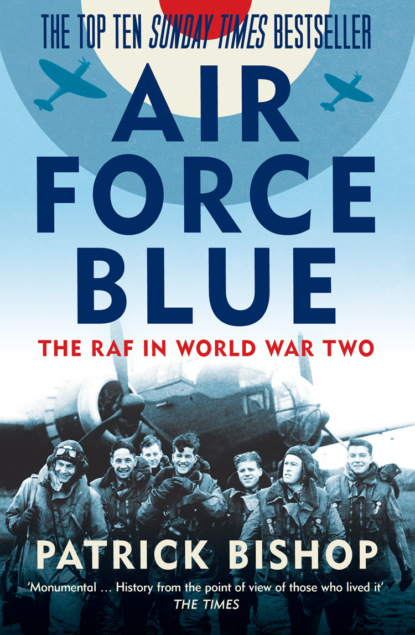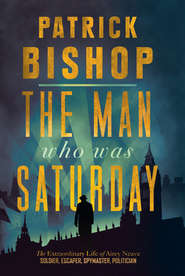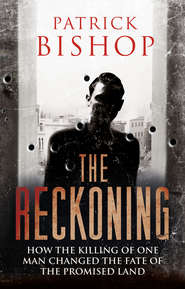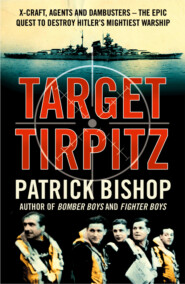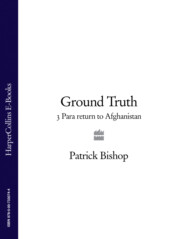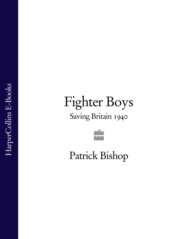По всем вопросам обращайтесь на: info@litportal.ru
(©) 2003-2024.
✖
Air Force Blue: The RAF in World War Two – Spearhead of Victory
Настройки чтения
Размер шрифта
Высота строк
Поля
Shadow of the Wing never made it to the screen but there were plenty of other air movies to keep audiences happy. Doom-mongering efforts like Things to Come were outnumbered by productions that showed military aviation in a heroic light. The Dawn Patrol was so popular it was made twice in the space of eight years. The second version starring Errol Flynn, Basil Rathbone and David Niven was a box office hit when it came out in 1938. It was an unsparing account of the life of Royal Flying Corps pilots operating on the Western Front in the summer of 1915 when German Fokker eindecker fighters were winning the battle for air superiority over the trenches. The men of 59 Squadron are a hard-drinking, fatalistic bunch. Among them are two friends, Dick Courtney and Douglas Scott, played by Flynn and Niven. They are at odds with their leader Major Brand (Rathbone) who has lost sixteen of his pilots in the previous fortnight, most of them greenhorns fresh from flying training school. The mental strain on a commander forced to send novices to almost certain death is convincingly depicted. But it also reinforces the propaganda message broadcast by both sides during the real war, which presented air fighting as a clean, almost chivalrous business in contrast to the industrial carnage going on in the mud below. Courtney is killed after shooting down the German ace von Richter. The film ends with an image of inescapable duty as Scott orders the remnants of the squadron off on another dawn patrol.
To many British boys who watched it, the film acted not as a dire warning about the perils of life in the Air Force but as a call to their spirit of courage, sacrifice and adventure. ‘It may sound a bit odd and unlikely but this film really did have a tremendous influence on me,’ remembered Charles Patterson.29 (#litres_trial_promo) ‘It struck me that though casualties were very heavy it was much the most wonderful and exciting way to go to war … some strange, but as it turned out accurate, instinct told me that if I was going to fight, this was about the only way that there was any chance of my doing it successfully.’ As a Mosquito pilot with Path Finder Force, Patterson would take part in some of the most audacious daylight raids of the war, dropping his bombs and then filming the results of the operation for later analysis.
The multitudes who read aviation magazines and followed the air races and the fortunes of celebrity aviators had little chance of becoming pilots themselves. Flying instruction at most clubs and commercial schools during the 1930s cost two pounds an hour when a young man starting out in a clerical or factory job would be pleased to get two pounds a week. A course aimed at securing a basic ‘A’ licence cost anything from £15 to £35.
The RAFVR offered a passport to the enchanted domain. It was open to any male between the ages of eighteen and twenty-five with a reasonable level of secondary education. Those accepted would receive flying training gratis as well as an annual grant of £25. The educational requirements were a barrier to a large proportion of British males, most of whom left school at fourteen. Many who came forward were from the ranks of the comfortably off. But there were also large numbers of bank clerks, shop assistants, and minor civil servants eager to seize what seemed a God-given chance to break out of their dull existences and realize their fantasies.
Despite the obvious attractions of the offer, the Air Staff felt the mood of the country was tricky. They detected a hostility to ‘militarism’ and were alarmed by the prevalence of pacifist sentiments. At an Air Council meeting in May 1936 Frederick Bowhill complained that ‘at present the Press give great prominence to pacifist manifestoes, particularly those from seats of learning, but make no attempt to inculcate a feeling among the youth of the country that service in its defence was a fine thing’. He proposed that ‘we ought … to aim at bringing about a change of heart in the Press’.30 (#litres_trial_promo)
Sensibly, the tone remained sotto voce, with publicity stressing adventure rather than patriotism, a wise approach given the mood of the times. In 1936 the Peace Pledge Union, inspired by a canon of St Paul’s Cathedral, was in its heyday, attracting hundreds of thousands of supporters across the political spectrum, united in their renunciation of war and determination to work to remove its causes.
As the threat from Germany mounted attitudes hardened and the service chiefs’ concerns about the willingness of the younger generation to fight would prove unfounded. When looking back, few would cite the worsening international situation or a sense of duty as a compelling motive for volunteering. ‘I was walking down the Strand and there was an RAF recruiting office with a poster in the window and it said “London businessmen join the RAF and fly aeroplanes at the weekend”,’ said Maurice Leng who was just starting out in the advertising business. ‘There were no patriotic reasons. I was interested in motor-racing but it was an expensive sport and I couldn’t possibly afford the cost of a decent car … here was this wonderful opportunity for flying these super aeroplanes provided by the government and that is exactly what I did.’31 (#litres_trial_promo) Brian Considine was a trainee at Unilever when he joined in January 1939. ‘I was nineteen and I don’t think I was bothered by [the political situation],’ he recalled.32 (#litres_trial_promo) ‘It was a way to learn to fly which was an expensive thing to do. In fact instead of paying out of one’s own pocket one was actually going to be paid to do it.’
Some who went on to have gallant wartime careers enjoyed emphasizing the unheroic motives that had impelled them into the Air Force in the first place. Christopher Foxley-Norris, who flew Hurricanes in the Battle of Britain, liked to claim that his main reason for joining the Oxford University Air Squadron was the £25 signing-on fee. It enabled him to buy a car which his older brother had told him was essential if he was to have any chance of attracting a girlfriend.33 (#litres_trial_promo) But he also admitted that though life in the squadron was ‘enormous fun, at the same time most of us realized there was going to be a bust up … but at least some of us were doing something about it while the rest were just sitting around’.34 (#litres_trial_promo)
Tony Smyth, a graduate chemist working at the paint manufacturer Manders, did not ‘join the RAFVR … from patriotism, but only to increase my pay and show me the world’.35 (#litres_trial_promo) Like Foxley-Norris he soon learned that the fun came at a price. When in the spring of 1937 he began his basic training as part of the first intake of volunteers at Prestwick elementary flying school near Glasgow, the CO in his welcoming address left them in no doubt as to what it was they were being trained for. ‘He told us … that the remilitarization of the Rhineland by Hitler had showed the world that German expansion as proposed in “Mein Kampf” was serious. An enlargement of the RAF was essential … to produce a reserve of civilian aircrew.’ As time passed the truth that they were learning to fight as well as fly became increasingly apparent.
If war was coming, the Air Force seemed a good place in which to spend it. Almost everyone eligible to fight had someone close to them who had been killed or maimed in the previous war and most of the casualties had been suffered in the trenches of the Western Front. Reluctance to repeat the previous generation’s experience was a powerful factor in choosing to serve in the relatively clean-seeming element of the air.
Tony Iveson’s police inspector father had been ‘shot on the first day of the Somme and very badly wounded. He had a huge scar on his chest … All my generation knew how horrible it had been.’36 (#litres_trial_promo) Growing up in York he heard his elders talk in ever more pessimistic terms about the crisis in Europe. ‘I knew that there was going to be a war and I knew who it was going to be with so I came through my teens with that in my mind.’ Early on he resolved that when it came ‘I just wanted to fly’. Iveson joined the RAFVR and flew in the Battle of Britain before eventually joining 617 Squadron – the Dam Busters.
There was also the question of comfort. The RAF seemed to offer a cushier existence than you could expect in the Army or Navy. Sir Edwin Lutyens had been among those consulted on the design of the stations that sprang up in the 1930s. They were built to high specifications and airmen, or at least officers, were thought to live well. Charles Patterson was self-aware enough to know he could ‘never have stood up to the rigours of fighting on land and in the dust and heat and dirt’. When later at a recruiting interview he was asked why he wanted to be a pilot he boldly replied, ‘because the only way that I could consider it possible to fight was if one was provided with central heating and constant hot water’.37 (#litres_trial_promo) The group captain heading the panel ‘gave me a broad smile and nodded approval and said: “Accepted. Recommended”.’
The first RAFVR entrants began training in April 1937. Tedder saved money by using the network of flying clubs across the country to supply the infrastructure, with the instruction being supervised by the RAF’s Central Flying School.38 (#litres_trial_promo) The reservists did basic training at an initial six- or eight-week course, at the end of which they were expected to go solo, then returned to their regular jobs and kept up training at weekends at local airfields operating under contract with the Air Ministry. The volunteers had only a semi-detached relationship with the RAF. They did not wear uniform and were part of a mass reserve rather than organized into squadrons like the Auxiliaries.
They started flying on Tiger Moths and similar easy-to-master aircraft and gradually progressed on to new types like the Avro Cadet before finally getting to grips with aircraft then in service in the squadrons. They also attended night classes in local towns to study basic aeronautics and navigation.
For those who had never flown the initial trip could come as an unpleasant surprise. Bob Doe, who, despite having left school at fourteen with no qualifications was accepted into the RAFVR, got his first taste of flying in June 1938. He worked as an office boy at the News of the World and took the train from Fleet Street to Hanworth aerodrome in south-west London for his first ‘air experience’. The machine was a Blackburn B2 in which pilot and pupil sat side by side. His instructor, a former stunt pilot with the Cobham circus, was, like him, a big man and they had to ‘sit a bit sideways’ to make room for each other. ‘I remember thinking how thin the sides of the airframe were and that it would not take much to fall out,’ Doe remembered.39 (#litres_trial_promo) ‘I was afraid of falling through it. When he banked the thing to turn round, looking down at the houses about four hundred feet below, it was a weird feeling. Quite frankly I was petrified …’
When they first got their hands on the controls novices learned that simple aircraft were delicate creatures and the sensations of handling were both disturbing and thrilling. Edward Hearn, a trainee estate manager from Folkestone, ‘was surprised to find the joystick extremely sensitive and even slight pressure had an effect on the machine’.40 (#litres_trial_promo) He felt he was ‘handling something so delicate that even a slight touch would send us tumbling earthwards’. Repetition brought familiarity and then confidence until the day came to go solo, a great, never-to-be-forgotten moment in every pilot’s life.
Hearn was a slow learner. The average time taken by pupils to go solo was ten hours. In his case, it was fourteen. Decades later he could still ‘distinctly remember this first venture alone in the air … strapped in, propeller swung, goggles down, I opened up the throttle and it was the feeling of power as speed was gathered over the grass that gave me assurance and stability’. Hearn made three careful left-hand circuits without mishap. This was the easy part. Getting down was the problem. The training school canteens buzzed with stories of pupils who had come in to land fourteen or fifteen times before summoning the courage to put the aircraft down. Some finally had the decision made for them when they ran out of fuel. A rough landing did not qualify for ‘that would mean a bounce and if the bounce was a real banger that would have meant opening up the throttle and going around again’. Hearn eventually brought the machine in smoothly, cutting the engine a few feet from the ground and drifting in to roll smoothly over to his relieved instructor.
The plan was to recruit 800 potential pilots a year but it soon became clear that the quota would easily be filled. The supply of pilot recruits, particularly in the London area, much exceeded the demand.41 (#litres_trial_promo) The problem was that everyone wanted to be a pilot. Few were interested in the less glamorous roles of observer – the contemporary term for navigators – and wireless operator/air gunner. The difficulty was solved when surplus pilots were diverted to fill the gaps in aircrew needs. By the time the war began there were 6,646 pilots in the ranks of the RAFVR; 1,623 had been trained as observers and 1,948 as wireless operators/air gunners.
The function of the RAFVR as a reserve did not last long. When the war started it became an administrative designation and the principal route for aircrew entry into the RAF. All those who applied for aircrew duties on their own initiative or chose the RAF when registering as required by the National Service (Armed Forces) Act which came into force in September 1939 joined its ranks. They were identified by a brass and cloth ‘VR’ worn on tunic lapels and shoulders. In 1943 the badges were phased out as they were considered divisive, though the surviving Auxiliaries were allowed to keep their distinguishing ‘A’.
The airmen who went into battle with the Luftwaffe were a compound of professionals and amateurs and represented a broad social and geographical swathe of Britain. The fusion was remarkably successful. In the judgement of the internal narrative, borne out by and large by the testimony of the participants, ‘so complete was the amalgamation that the distinctions of peacetime between the component parts ceased to be discernible and the memory of them failed to have any significance’.42 (#litres_trial_promo)
Those leading the force in the rush to war had managed to create a solid identity for a hugely expanded organization that would only get bigger with time. It was shared not only by the fliers but by the much larger number of men and women who kept them in the air.
5
‘There’s Something in the Air’ (#ulink_0c36ecbb-160d-5773-953a-d3ab71581d11)
When the war broke out there was no repetition among the civilian population of Britain of the ‘tragic enthusiasm’ of August 1914. Most of those of fighting age fell in reluctantly, but quietly, with the demands that a succession of government decrees made of them, starting with the April 1939 Military Training Act. They accepted the need to serve, not because they wanted to, but because Hitler had given them no choice.
Full-scale conscription began on the first day of hostilities with the passing of the first National Service (Armed Services) Act and all males (with significant exemptions) between the ages of eighteen and forty-one were liable to call-up. The upper age limit for men was later increased to fifty-one, and from December 1941 single women and childless widows between the ages of twenty and thirty were required to report for war service.
On call-up, men had first to register, usually at their local Labour Exchange. There, they were asked to make a profoundly important choice. Which branch of the armed services would they prefer to spend their war in? Thus was created a popularity contest between the Army, Navy and Air Force. Initially, the RAF won it hands down. Of the 230,000 men aged twenty to twenty-two registering for the first conscription proclamation of 21 October 1939, nearly 30 per cent said they wanted to join the Air Force. The Navy was second with 17 per cent.1 (#litres_trial_promo) The rest appear to have taken the fatalistic decision to go where they were sent. In February 1941, when the conscription net was thrown wider to scoop up nineteen-year-olds, nearly 50 per cent opted for the RAF against 18 per cent for the Navy.2 (#litres_trial_promo)
Many decided not to wait to be summoned but reported to one of the Combined Recruiting Centres dotted around the country to volunteer for the Air Force. Indeed, enlistments by those outside the conscript age range outnumbered pressed men until well into 1940.
RAF recruiting staff could therefore afford to be choosy as they surveyed each new crop of sprogs. In the first five years of the war, of those who volunteered before waiting to be called up about one in six were rejected. Among those who waited to be summoned before plumping for the Air Force, the washout rate was brutal. Less than half of those interviewed by recruiting officers made the grade (463,773 out of 1,054,348), and many of them were shunted off to the Army.3 (#litres_trial_promo)
In the first sixteen months of the war, 203,239 volunteers were accepted into the RAF, together with another 140,462 who opted for the Air Force on being called up.4 (#litres_trial_promo) Having succeeded in joining their preferred service, each man had another crucial – and potentially fatal – choice to make. At an early stage they were asked whether they wanted to serve in the air or on the ground. Of the 343,701 who entered in that initial period only about one in ten – 35,267 – were assigned to aircrew duties.5 (#litres_trial_promo) Among younger men, a figure of 13 per cent of aircrew optants was normal until recruiting tailed off in 1944.6 (#litres_trial_promo)
Why was it that so many ended up earthbound? It was not a simple question of choice. One reason was that far more technical tradesmen were needed than aviators, and anyone with a relevant skill would be steered towards a ground job. Another major factor was the high standard of physical fitness and intelligence set for those who volunteered for flying duties. Flying required a higher degree of academic ability than most military activity and, initially, priority was given to those with more than the legal minimal level of secondary education.
In 1939 four out of five children left school at fourteen when free education more or less ceased.7 (#litres_trial_promo) The result was that the great majority of the first-wave applicants were automatically excluded from a flying career. Gloucestershire boy F. S. Reed had enjoyed a ten-shilling joy ride at the RAF aerodrome at South Cerney and was ‘hooked on flying’. When the war came he decided to join the Air Force but ‘having no academic qualifications I didn’t have a hope of being accepted for pilot training’. Instead he ‘applied to join the RAF … as a flight mechanic. If I couldn’t fly them then at least I could work on them.’8 (#litres_trial_promo) Fate determined that he would spend most of the war servicing aircraft in a flying training school in South Africa.
A job on the ground had many attractions. Working as a skilled tradesman brought greater standing and a higher level of satisfaction than an Army or Navy other rank could expect. This status was reflected in the uniform for, unlike his counterparts, from 1938 onwards the ‘erk’ wore a collar and tie (it was six years before the Army caught up). Initially at least, there seemed a diminished likelihood of being sent overseas. It was also evident that ground crew duties carried less risk than serving in the air, or indeed anywhere. The importance this factor played in the decision-making process is hard to calculate. Wing Commander Jimmy Lawson of the Air Ministry Personnel Department recorded in a memorandum that ‘it is believed that a number of young men enlisted voluntarily or opted for the RAF on ground duties with the knowledge that such employment was the least dangerous in any of the services’.9 (#litres_trial_promo)
How Lawson, who elsewhere in the document shows himself to be sensible and humane, arrived at this conclusion was not made clear. It cannot have been his intention to portray aircraftmen as shirkers. Those who served on the ground anyway displayed their own brand of fortitude, enduring long hours in all weathers and often miserable conditions, and could show the same selfless disregard for their own lives when duty called, as an entry in the diary of 217 Squadron recording an air raid on their base at St Eval in Cornwall in May 1941 shows: ‘A/Cs Collier and Ball put up a very good show by towing a bowser which was on fire away so that it could burn out in safety. One of them actually had to climb under the bowser to attach a cable to it. Their prompt and courageous action undoubtedly saved another aircraft from destruction.’10 (#litres_trial_promo)
There was a steady flow of non-flying personnel who, despite intimate knowledge of the dangers involved, gave up a safe billet to volunteer for operations. It was not as straightforward a process as the authorities made it appear and answering the call did not guarantee acceptance, even at times when the need appeared to be urgent. ‘Chaps, driven by boredom, volunteer continually for Air Gunnery, but they aren’t accepted,’ wrote John Sommerfield to a colleague in November 1940. He was a former public schoolboy and a Communist who had fought with the International Brigades in Spain before joining up as a lowly aircraftman. ‘In the meantime the RAF goes on inserting 11 inch double column ads [in newspapers and magazines] for men to be aircrew.’11 (#litres_trial_promo)
An initial insistence on education to School Certificate standard was eventually dropped on the grounds that it ‘debarred many excellent candidates otherwise suitable’.12 (#litres_trial_promo) Nonetheless it is clear that many who wanted to fly could not because they had not been given the basic education that would prepare them for the rigorous classroom training that all aircrew roles required. Geoffrey Goodman was bright and ambitious but his war-invalid father had been unable to find steady work and he had left school early. He was seventeen when the war broke out, working as cub reporter for a small magazine in Camden Town, north London. His Jewish background and left-wing sympathies reinforced his determination to fight Fascism and he felt flying with the RAF – ‘the most dramatic of the three services’ – was the best way to do it.13 (#litres_trial_promo) When, having added a year to his age, he turned up at a recruiting office near Euston station, he found it was not as easy as that. ‘I wanted to go straight into aircrew [but] I didn’t have the required qualifications,’ he said. ‘I remember arguing with the recruiting sergeant who told me that once [I] was in I may be able to remuster.’ At the reception centre at Cardington he was advised to volunteer to train as a radio mechanic as an entrée to aircrew. While training at Cranwell a flight lieutenant told him he would be better off specializing in photography – a tip he followed and which led to him eventually being commissioned as a reconnaissance pilot. Goodman found that ‘about a third of the groundcrew lads wanted to get into aircrew – it didn’t matter what it was. If it wasn’t as a pilot then as a navigator or air gunner.’ The stumbling block was education – or lack of it. They ‘wished to do so but they were very much aware that they didn’t have the … qualifications to tackle the aircrew course’.
In the first five years of the war RAF numbers increased sixfold – from 175,692 in September 1939 to 1,185,833 in July 1944.14 (#litres_trial_promo) This stupendous growth spurt required production-line methods to manage and for many recruits the plunge into uniform was disorienting, often shocking. They were passing from the realm of the comfortable and familiar into a baffling new domain that seemed unconnected with the civilian universe, filled with noise, discomfort and a total absence of privacy. The first stop for all, whether you were destined to be a pilot, a fitter or a ‘general duties’ dogsbody was one of the reception centres like Uxbridge, on the fringes of west London, Cardington in Bedfordshire, or Padgate, Lancashire, where you swapped your civvies for a uniform and acquired a service number that would henceforth be welded to your name.
Padgate was a vast, ugly, hutted camp near Warrington. No one who passed through its gates retained any happy memory of the place. ‘My main impression of Padgate is parading and waiting in biting cold and rain,’ John Thornley, a twenty-nine-year-old printer’s rep from Preston, confided to his diary after arriving there in December 1940. ‘The camp is built on marshy ground and is open to all winds.’15 (#litres_trial_promo) Even young men who knew poverty and overcrowding felt the rawness of the place, and cringed at the constant state of exposure in which it seemed they would henceforth live. The nakedness was literal. Almost the first order an RAF entrant received was to drop his trousers and pants, prior to an inaugural ‘FFI’ (Freedom from Infection) inspection, one of many he would undergo in his career.
Nineteen-year-old Norman Lee, who had left his reserved occupation job with an engineering firm in Yorkshire to emulate his twin brother and volunteer for aircrew, arrived in Padgate in November 1941. For his first FFI he and his comrades ‘were lined up in a hangar facing the open side with only a sheet of hessian as a very inadequate screen between us and a crowd of WAAFs who giggled and made faces through the window of a low building opposite.’16 (#litres_trial_promo) Then ‘to complete our embarrassment, as soon as the inspection was over we were marched straight into that self-same building’ where the female spectators served them plates of gristly brawn.
For gently brought-up young men like Sam Pritchard, the son of a Wesleyan minister who turned up in the spring of 1940 on his way to becoming a navigator, Padgate brought his first, rather dismaying, close encounter with the British proletariat. The thirty men in his barrack room ‘contained what I suppose must have been a cross-section of British society; a few types with a reasonable education and the remainder representing rapidly dwindling standards [down to] a group of foul-mouthed objectionable young men’.17 (#litres_trial_promo) His first night was ‘miserable and unforgettable … lying in a bed with no sheets on; a mattress and a pillow filled with straw, looking round for a sympathetic or understanding face …’
By this rough immersion, the RAF might have unintentionally been doing the new boys a favour. It was sink or swim. To survive you had to cling to the nearest kindred spirit, and the experience encouraged instant and often lasting friendships. There was sanctuary, too, in the humour that pervaded everything: strong, black and subversive. Surreal wit combated their surreal new circumstances. As everyone constantly told everyone else, ‘if you can’t take a joke, you shouldn’t have joined’.18 (#litres_trial_promo)
Sam Pritchard and his comrades soon discovered ways to circumvent the obscenity-flecked rule of the NCOs who drilled them. A ‘favourite stratagem was to start giggling or laughing on parade whilst punctiliously and smartly obeying all the orders barked at us. This would first puzzle the corporal and then drive him to foul-mouthed hysteria … eventually when [he] finally accepted the impracticality of charging all of us under King’s Regulations, he would lower his voice to offer an extra pass out of camp if we “stopped our bleeding laughing”.’
Any manoeuvre that thwarted authority or made it look ridiculous delighted men who were, on the whole, determined to hang on to their status as civilians in uniform. During his initial training my father Ernest Bishop was in a group being taught self-defence by an overbearing PT corporal instructor. One by one, the teacher invited each man to ‘take a swing’, then promptly knocked him flat when he obeyed. Come my father’s turn, he warned the corporal that he had ‘done a bit with the gloves’, as indeed he had, fighting as ‘Tiger’ Bishop at the Blackfriars Ring in London. ‘They all say that,’ sneered the corporal, and waved him on. Moments later the instructor was stretched out cold on the gym floor and Ernie did not have to buy beer for a fortnight.
Places like Padgate were purgatorial rather than hellish and the suffering was temporary. Sam Pritchard’s grim memories were soon blotted out in the summer of 1940 by the far more agreeable experience of No. 2 Initial Training Wing, based in Cambridge University. Pay parades took place on the lawn in front of King’s College Chapel and in the evenings he and his fellow trainee pilots and navigators toured the pubs. They were a superior crowd to the reception centre clientele. The majority were grammar school boys like himself but there was also ‘a goodly proportion from Public schools, and some even who had completed a university course’, as well as Australians, New Zealanders and Canadians.19 (#litres_trial_promo) For the first time he ‘met other young men in their early twenties who were smarter, richer, better-looking, better-educated and more amusing than I considered myself to be’.
In the RAF you tended not to linger anywhere for too long. Specialized requirements and constant technological advances meant long training periods at a variety of establishments. It took Ted Mace, who signed on as an aircraft electrician, a full year of more or less continuous instruction at various technical schools before he was posted to a squadron.20 (#litres_trial_promo)
Aircrew training was more intensive. Pilots went through nine phases of instruction before they flew their first operation, and when bottlenecks in the system developed early in the war, periods of ‘deferred service’ at home extended the process. Even training for a relatively uncomplicated trade such as air gunner was a protracted business. Norman Lee volunteered in November 1940 but did not take to the air with 428 Squadron until the summer of 1943.21 (#litres_trial_promo)
The RAF’s geographical reach spread enormously in the course of the war. The empire had greatly helped its training needs by agreeing to flying training schools in the wide skies of Canada, Australia, Rhodesia, South Africa and elsewhere. With expansion, new bases sprang up all over each new theatre of war and old ones were enlarged. Air Force life could thus be amazingly peripatetic, with constant moves from training course to training course, from station to station, from one end of the country to the other and to every corner of the globe. An airman might find himself shivering in Iceland, hard up against the Arctic Circle, cursing the flies in the Nile Delta, or sweating in the sultry humidity of Takoradi on the Gold Coast (Ghana) of Africa.
However grim your current circumstances there was always the prospect of change. ‘It is like living in a cross between a public school and a concentration camp,’ wrote John Sommerfield, in 1941 shortly after arriving at Silloth, a remote station in Cumberland.22 (#litres_trial_promo) ‘The town of Silloth is hideous, small and unpleasant … Cumberland has the highest average rainfall in Great Britain …’ Before long, though, he was writing notes on the nature of the Western Desert (‘the sinister shadows of stones at sunrise, the purplish sunset shadows that dramatize sand ripples into mountain ranges …’) that he would put to good use when he resumed his career as a novelist and short story writer after the war.23 (#litres_trial_promo)
Wherever they went, the airmen carried with them a comforting, familiar ethos to sustain them. In its short life, the RAF had developed its own way of speech, some of it the legacy of its Army and Navy origins, much of it new. Like Sommerfield, Roderic Papineau was a writer who served in the ranks. Both acted as field reporters for Tom Harrisson, one of the founders of Mass Observation, set up in 1937 to study the lives of ordinary people and which continued its work into wartime. In May 1941, while with 256 Squadron in Blackpool, he compiled an ‘Airman’s Vocabulary’ recording the usages he heard around him in workshop, NAAFI and pub.24 (#litres_trial_promo)
He and his comrades were ‘erks’, a term that applied to all other-ranks ground staff. Its origin would never be satisfactorily explained. Even Eric Partridge failed to nail it and his theory, proposed in his 1945 Dictionary of RAF Slang, that it was a corrupted abbreviation of ‘air mechanic’, does not convince.25 (#litres_trial_promo) ‘Type’ was a handy alternative to ‘bloke’. Aeroplanes were ‘kites’ or ‘crates’. The rumours that hung like ground mist over base and depot (as they did over all military establishments) could be graded for reliability as ‘the real griff’ – almost certainly true, through ‘pukka gen’ – quite possible – to ‘duff’ or ‘shithouse gen’ – almost certainly bollocks. An expression that seems unique to the RAF was ‘by the centre!’, usually with an expletive inserted, to indicate ‘amazed and outraged disgust or surprise’. It does not appear to have lingered long in use after the war though Sam Pritchard chose it as the title for his memoir.
Some phrases had a different meaning for ground staff than for fliers. According to Papineau, when an erk was ‘shooting a line’ he was ‘pretending to unwarranted expert knowledge’. When a pilot did the same he was making some exaggerated boast, usually in the bar, and his utterance might well be recorded in the squadron ‘line book’. The 9 Squadron book reports Pilot Officer Arnold announcing loftily one night: ‘No I’m not keeping a diary, but I have the press cuttings of my flights …’26 (#litres_trial_promo) A ‘shaky do’ on the ground was a ‘disappointing or unsatisfactory affair’. In the air, it meant a terrifying near-death experience, and was all the more eloquent for its understatement. A word that meant the same to all was ‘wizard’ – ‘superb’, according to Papineau.





